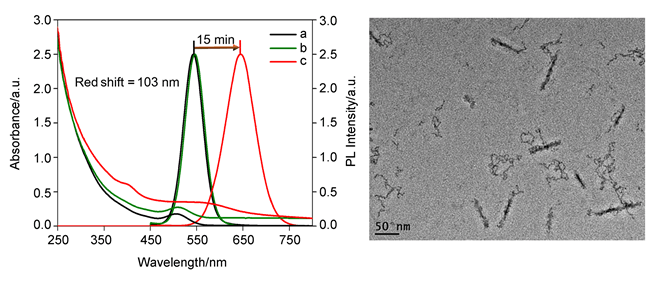摘要/Abstract

报道了一种简易、快速调节量子点荧光波长的方法.以GSH为配体水热法合成了发射波长为540 nm左右的绿色荧光CdTe量子点,通过(NH4)2MoS4在加热和常温条件下引导CdTe量子点进行自组装.加热条件下,15 min内可以使发射波长迅速的红移100 nm以上.常温条件下,在48 h内可以缓慢的引导CdTe量子点进行自组装,发射波长缓慢红移70 nm以上.利用对比实验验证了(NH4)2MoS4中的MoS42-对引导CdTe量子点自组装具有特异性,并且构建了一个合理的自组装体的结构单元模型.在细胞成像领域,该自组装体具有潜在的应用前景.
关键词: CdTe量子点, (NH4)2MoS4, 自组装, 模型, 细胞成像
Conventionally, red shift of QD photoluminescence (PL) could be achieved by growing QDs to larger sizes using hydrothermal method, which is usually a very slow process. We synthesized green fluorescent CdTe quantum dots with GSH as the ligand and proved the successful synthesis of (NH4)2MoS4 by UV-Vis, X-Ray Diffraction, Raman spectroscopy. In the process of research, we found that (NH4)2MoS4 can change the wavelength of CdTe quantum dots under the condition of heating or at room temperature. Redshift of emission wavelength can change with the different ratio between (NH4)2MoS4and CdTe QDs. In this study, we report a rapid and convenient method to achieve red-shift of CdTe QD PL via (NH4)2MoS4-guided QD self-assembly. We show that the emission wavelength of CdTe QDs underwent a red-shift of more than 100 nm for 15 min at 100℃ in the presence of (NH4)2MoS4. At the same time, we conduct a experiment, which have no red-shift in the absence of (NH4)2MoS4 for 15 min at 100℃. This illustrates that the (NH4)2MoS4 plays an important role in CdTe QDs self-assembly. The red-shift of QD PL was also observed at room temperature but relatively slower. The formation of QD assembly was confirmed by gel electrophoresis, transmission electron microscopy, and X-ray photoelectron spectroscopy. The result of gel electrophoresis and transmission electron microscopy directly shows the self-assembly morphology of CdTe QDs and the change of size and shape. Self-assembly entity was proved to contain Mo and Cd by the X-ray photoelectron spectroscopy, which confirmed the connection between (NH4)2MoS4and CdTe QDs. A control experiment was conducted by replacing (NH4)2MoS4with Na2S for QD assembly, in that case no apparent change of emission wavelength was observed. These results reveal that MoS42- within (NH4)2MoS4 is crucial for self-assembly of CdTe QDs. Accordingly, we propose a reasonable model of (NH4)2MoS4-guided CdTe QD self-assembly. In this model, we consider the connection between a (NH4)2MoS4 and two CdTe QDs in ideal condition. With the increasing ratio of (NH4)2MoS4, much more connection between (NH4)2MoS4 and CdTe will be obtained. Assembling entity morphology changed with different cross-linking way. The resulting QD assembly was further applied to cell imaging experiments, demonstrating their potentials in this field.
Key words: CdTe QDs, (NH4)2MoS4, self-assembly, model, cell imaging
PDF全文下载地址:
点我下载PDF
